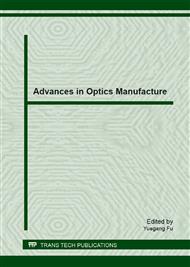[1]
Boreman, G.D., Modulation Transfer Function in Optical and Electro-Optical Systems, SPIE, Bellingham, WA, (2001).
Google Scholar
[2]
Levy, E., Peles, D., Opher-Lipson, M. and Lipson, S.G., Modulation transfer function of a lens with a random target method, Appl. Opt. 38, 679-683 (1999).
DOI: 10.1364/ao.38.000679
Google Scholar
[3]
Arnison, M. R., Morgan-Mar, D. P., Deller, C. A., Fletcher, P. A. and Larkin, K. G., Measurement of the lens optical transfer function using a tartan pattern, Appl. Opt. 50, 2158-2169 (2011)
DOI: 10.1364/ao.50.002158
Google Scholar
[4]
Loebich, C., Wueller, D., Klingen, B. and Jaeger, A., Digital camera resolution measurement using sinusoidal siemens stars, IS&T/SPIE Electronic Imaging, 65020N, 1-11 (2007).
DOI: 10.1117/12.703817
Google Scholar
[5]
Sitter Jr, D. N., Goddard, J. S. and Ferrell, R. K., Method for the measurement of the modulation transfer function of sampled imaging systems from bar-target patterns, Appl. Opt. 34, 746-751 (1995)
DOI: 10.1364/ao.34.000746
Google Scholar
[6]
Boreman, G. D. and Yang, S., Modulation Transfer Function Measurement Using Three- and Four-bar Targets, Appl. Opt. 34, 8050-8052 (1995)
DOI: 10.1364/ao.34.008050
Google Scholar
[7]
Hon-Sum, W., Effect of knife-edge skew on MTF measurement of CCD images employing a scanning knife edge, Opt. Eng. 30, 1394-1398 (1991).
DOI: 10.1117/12.55941
Google Scholar
[8]
C. Mathew, Tomas and Paul Zagarino, Dynamic Modulation Transfer Function Measurement in Gated Microchannel-plate Image Intensifiers, SPIE, 1757, 32-39(1992)
Google Scholar
[9]
Xiang Shiming, Zhu Hongquan and Wang Kuiluc, Temporal-spatial MTF performance analysis of a proximity-focused-image intensifier as a camera electronic shutter, SPIE, 6279(2007)
DOI: 10.1117/12.725161
Google Scholar
[10]
Andrew R Harvey, Gonzalo D Muyo and Tom Vettenburg, Control of optical aberrations with coded apertures, SPIE ,8165(2011)
Google Scholar
[11]
Birch P. M., Gourlay J., Love G. D., and Purvis A., Real-time optical aberration correction with a ferroelectric liquid-crystal spatial light modulator, Appl. Opt. 37, 2164–2169 (1998).
DOI: 10.1364/ao.37.002164
Google Scholar
[12]
Webster Stayman J., Subotic N., and Buller W., An analysis of coded aperture acquisition and reconstruction using multi-frame code sequences for relaxed optical design constraints, Proc. SPIE 7468, 74680D (2009).
DOI: 10.1117/12.825347
Google Scholar
[13]
Slinger, C., Eismann, M., Gordon, An investigation of the potential for the use of a high resolution adaptive coded aperture system in the mid-wave infrared, SPIE Vol. 6714, 67140 (2007).
DOI: 10.1117/12.736071
Google Scholar


